Friday, February 23. 2007
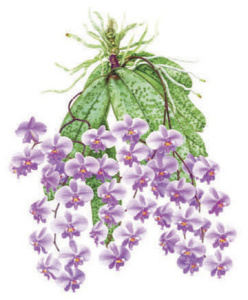 The best orchid show in the world opens Feb 24 at the NY Botanical Garden. Worth a drive. (That's a Schilleriana on the right) The best orchid show in the world opens Feb 24 at the NY Botanical Garden. Worth a drive. (That's a Schilleriana on the right)
I think these two Maggie's Farm readers below were in a bit of a hurry to get through the toll booth to catch the Orchid Show. The real question is - Whose EZ Pass paid the $3.50 toll? (I think it was the schlemozl on the right, and the schlemiel on the left tried to sneak past his "GO" signal.) Good old New York - if you can make it there, you can make it anywhere. Just throw your manners overboard. 
Tuesday, November 14. 2006
Some years we can have roses in bloom in the garden on Thanksgiving, in Yankeeland, especially if they are well-protected by a house, wall, or protection from cold wind. These sent in by a reader in CT, photos taken yesterday. Blooms among the falling leaves - there's a metaphor hiding in there. 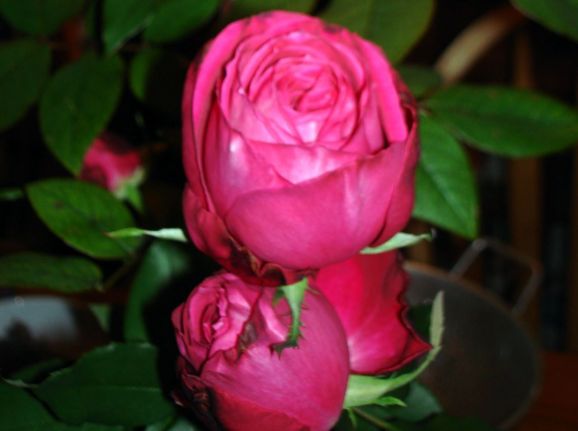
Sunday, September 17. 2006
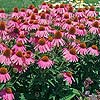 We did a post on Goldfinches in the past. We have discovered, this year, that the Goldfinches like echinacea seeds as much as they like thistles. Sitting on them every morning. There is nothing like birds and butterflies to add color and vitality We did a post on Goldfinches in the past. We have discovered, this year, that the Goldfinches like echinacea seeds as much as they like thistles. Sitting on them every morning. There is nothing like birds and butterflies to add color and vitality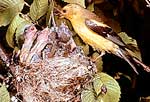 to a garden. They provide the movement, like dancers on a stage set. to a garden. They provide the movement, like dancers on a stage set.
A sterile garden, with no animal life, is dull. Need the birds and bees to make it complete. Echinacea, aka Purple Coneflower, aka Snakeroot, is a Great Plains plant or herb. The usual forms are tall, for the back of the border, (and tend to tip over about now) but there is a shorter version now.
Tuesday, August 29. 2006
One of our old hayfields has been over-run with Goldenrod. It makes for a pretty sight in August, but there is no hay there anymore, and the upper part is all Milkweed, to the delight of the Monarch butterflies. Rather than trying to rehabilitate it as a hayfield by deep-plowing, re-seeding for a couple of years with red clover, and plowing again and re-seeding with good hayseed, the current low-cost plan is just to mow it every two years, and to let the animals and birds enjoy it - which they do. Don't need more hay. Sparrows, snakes, and Wild turkey like it as is. And deer, of course, by the bushel. And I have noticed that the beaver come out of the marsh to eat stuff in the meadow at night. I have planted junipers next to the rocks, because with high growth you cannot see the rocks when you mow. Also, putting Bluebird houses on each rock, which the Tree Swallows seem to take over. Last summer I stupidly drove a tractor right up on one rock, about a 3' item I forgot about, and not only did it scare the bejesus out of me, but it also took another tractor to pull it off. Picture the front wheels of a Farmall four feet in the air, and a boulder jammed under the crankcase. Three Stooges. Mark the rocks before you mow. A good adage in rocky Yankeeland, where glacial boulders are one of our main crops. Like measure twice, cut once. You can see how the dang White Pines had been invading that field about 15 years ago. That process has been halted by aggressive border patrol, but it's a big job to roll it back. Cannot get a logging truck over the bridge, so it's sweat and chain saw. One step at a time. It's an excellent work out. 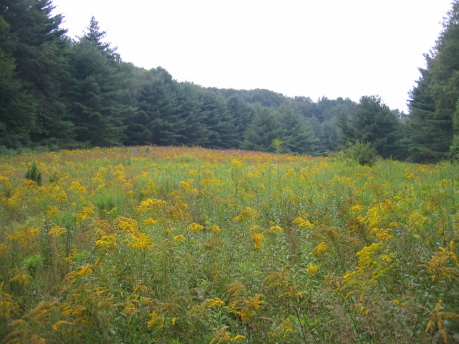
Sunday, August 27. 2006
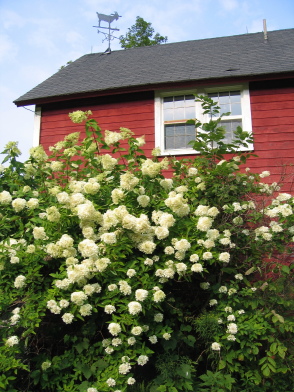 These guys need serious pruning, this winter. About 15' tall, but these are old-fashioned, and they bloom like crazy, with no care whatsoever. These are very happy with full sun, but they do not require it. Half is enough, for most varieties. But some seem to desire sun, despite the labels, and others wilt. I see a huge weed, though. A baby tree, pushing up through the bush. Missed it, somehow, but the photo makes it clear. Its fate is sealed, at a time of our chosing. Gardening is war against wild nature. Nothing "green" about it. Most of gardening is plant-murder (aka "weeding").
Tuesday, August 15. 2006
We may be the only blog in the world who finds slime molds (good photos there of different varieties, including photo below) interesting. The first time you see one on the forest floor, the garden, or the edge of the lawn, you tend to think somebody spilled some poisonous orange glop from a bucket. They are difficult to categorize: not exactly fungi, and not exactly protista, but probably more like protista - eg animals. Their colony creeps around slowly, munching on bacteria, and when they run out of food, they creep into the sun and form spores, and wait. There is new science on how this thing adjusts to changing conditions. 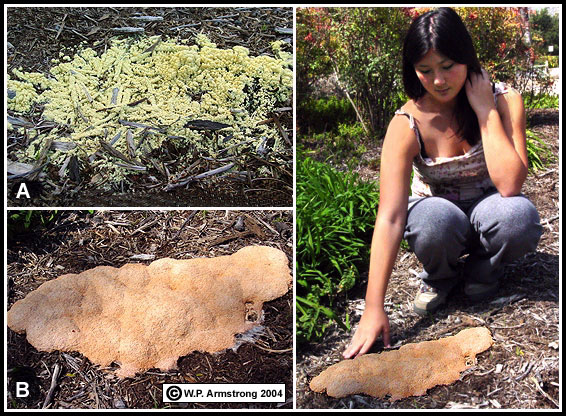
Saturday, July 29. 2006
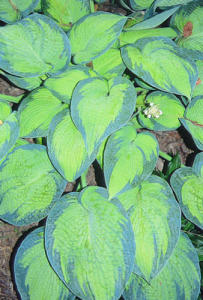 Hostas are often viewed as a junky plant. They are not. When they are in a small clump in the sun in front of a bank, they look awful. Hostas are often viewed as a junky plant. They are not. When they are in a small clump in the sun in front of a bank, they look awful.
They need to be massed, and in the shade - minimal to no direct sun, and humusy soil. The variety available these days is remarkable. Some people (not us) remove the blooms, preferring them only for the simple and understated foliage. Once known as the Plantain Lily, their origins are in Northeast Asia. One of their virtues is that they shade out all weeds. Another is that they now come in all sizes, from miniature to giant. Here's the Hostamania site. Here's the Hosta Forum at Garden Web. Another good one - My Hostas. Some very cool Hostas at this nursery. Image is of their Bright Lights. Wayside has a good selection too. Every type of garden plant has its fans and afficionados. As hobbies go, it's as pleasant and harmless as gun collecting...but cheaper. And guns, alas, do not reproduce.
Sunday, July 16. 2006
Our Crocosmia is in full bloom, but a bit weighted down by their flowers, and by over-growth from all of the rain. The bulbs are fairly expensive (wrong - mine were $35 years ago, but cheap now), but they spread vigorously in a sunny spot and you soon have bulbs (I think they are technically "corms") to give away. Hummingbirds love these. (lens had a little condensation from coming out of the A/C) Tropical-looking, they grow well in Yankee-land. 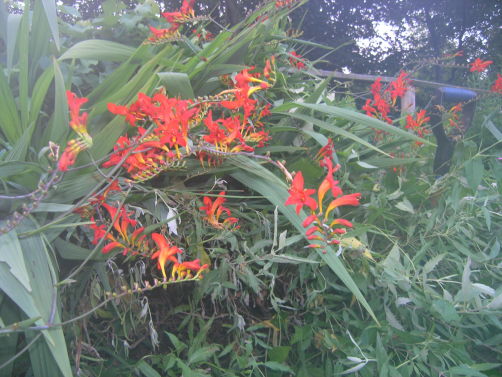
Saturday, September 17. 2005
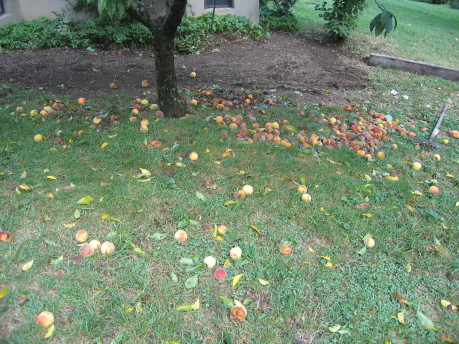 Country Pie Country Pie
Ophelia gently blew through here yesterday, resulting in a literal windfall of nearly-ripe and ripe peaches. Peaches ripen in late Aug-Sept. up here in Yankee-land. The yard guys must have eaten a dozen yesterday, juice running down their chins, (I don't spray 'em), but there are a couple of bushels more, on the ground and on the tree. Plenty enough to spare some to the squirrels and possums and box turtles that love 'em. So the splendid youngest daughter made her dad a peach pie. Wow. Crust from scratch, too. Nothing better. Can't dare dilute it with ice cream...plus I didn't see any in the freezer. Now to yard work and maybe fishing later. (Listening to: Sweet Melissa, Allman Brothers)
|


 The best orchid show in the world opens Feb 24 at the
The best orchid show in the world opens Feb 24 at the 

 We did a post on
We did a post on  to a garden. They provide the movement, like dancers on a stage set.
to a garden. They provide the movement, like dancers on a stage set. 


 Hostas are often viewed as a junky plant. They are not. When they are in a small clump in the sun in front of a bank, they look awful.
Hostas are often viewed as a junky plant. They are not. When they are in a small clump in the sun in front of a bank, they look awful. 
 Country Pie
Country Pie